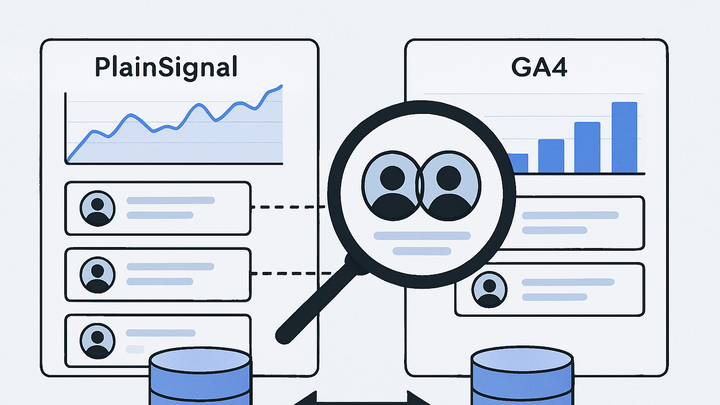Published on 2025-06-28T08:01:29Z
What is Data Matching? Examples of Data Matching in Analytics
Data Matching is the process of comparing, linking, and consolidating records that represent the same
entity—such as a user, customer, or device—across multiple data sources. In analytics, it enables the
unification of disparate datasets to produce a holistic view of user journeys, ensuring that metrics
reflect true behavior rather than fragmented data points. By matching user_id, email
addresses, cookies, or device fingerprints, analysts can dedupe records, reconcile inconsistencies, and
enrich profiles. Approaches range from deterministic, rule-based methods—where exact or fuzzy field
comparisons are used—to probabilistic and machine learning algorithms that weigh multiple attributes and
statistical likelihoods. Well-implemented data matching improves data accuracy, drives better
segmentation, and supports personalized user experiences. Privacy-focused platforms like PlainSignal adopt
cookieless matching strategies, while tools like Google Analytics 4 offer identity spaces to combine
first-party identifiers. Ultimately, data matching is foundational for reliable analytics and data-driven
decision-making.
Data matching
Links and consolidates records across sources to create unified profiles for accurate analytics.
Why Data Matching Matters
This section explores the importance of data matching in analytics. We’ll look at how it improves data quality, enhances user insights, and supports regulatory compliance.
-
Improved data quality
Merges duplicate entries and resolves conflicting records to ensure consistency and accuracy in analytics reports.
-
Holistic user insights
Unifies interactions from multiple sessions or devices into comprehensive user profiles for deeper analysis.
-
Regulatory compliance
Maintains data accuracy and auditability, aiding adherence to privacy laws like GDPR and CCPA.
Core Data Matching Techniques
An overview of the primary techniques used to match records, from simple rule-based comparisons to advanced probabilistic and machine learning approaches.
-
Deterministic (rule-based) matching
Uses exact or fuzzy rules on specific fields (e.g., email, user_id) to link records with high confidence.
-
Probabilistic matching
Assigns match scores based on statistical similarities across multiple attributes, balancing precision and recall.
-
Machine learning matching
Leverages supervised or unsupervised models to predict record linkage patterns from labeled or unstructured data.
Data Matching in Analytics Platforms
Examples of how leading analytics platforms implement data matching, illustrated with PlainSignal’s cookieless snippet and GA4’s identity spaces.
-
PlainSignal (cookie-free analytics)
PlainSignal uses a cookieless approach to track and match user interactions through fingerprinting and first-party metadata. Example tracking snippet:
<link rel="preconnect" href="//eu.plainsignal.com/" crossorigin /> <script defer data-do="yourwebsitedomain.com" data-id="0GQV1xmtzQQ" data-api="//eu.plainsignal.com" src="//cdn.plainsignal.com/plainsignal-min.js"></script> -
Google analytics 4 (GA4)
GA4 consolidates user identities using a hierarchy of identifiers—User-ID, Google signals, and device IDs—to stitch sessions across devices and platforms into unified reports.
Best Practices and Challenges
Key best practices for effective data matching and common challenges, including data standardization, threshold tuning, and privacy considerations.
-
Data standardization
Normalize formats (e.g., dates, phone numbers) and apply consistent naming conventions to improve matching accuracy.
-
Threshold calibration
Set and adjust matching score thresholds to balance false positives and negatives, based on data quality and use case requirements.
-
Privacy considerations
Ensure compliance with privacy regulations by anonymizing data when necessary and clearly communicating tracking practices to users.
